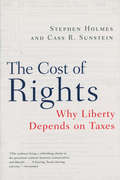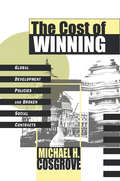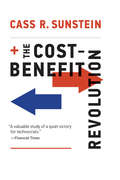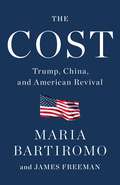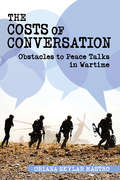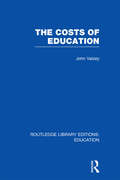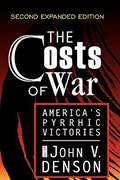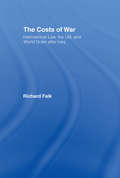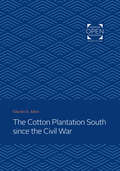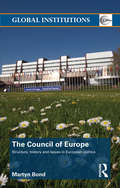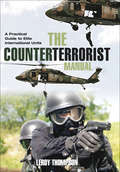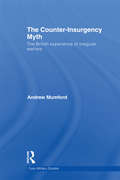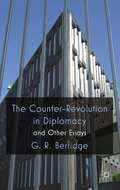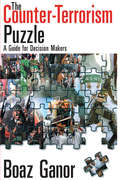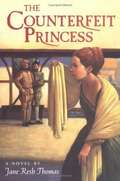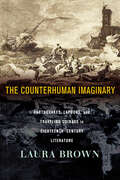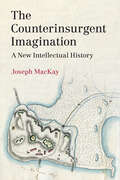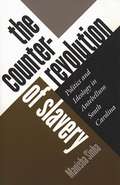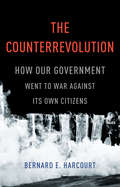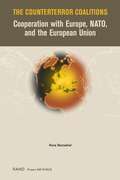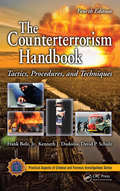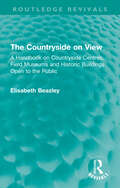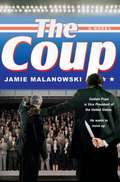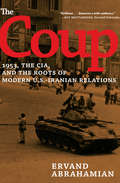- Table View
- List View
The Cost of Rights: Why Liberty Depends on Taxes
by Cass R. Sunstein Stephen HolmesTo "fight for your rights," or anyone else's, is not just to debate principles but to haggle over budgets. The simple insight that all legally enforceable rights cost money reminds us that freedom is not violated by a government that taxes and spends, but requires it--and requires a citizenry vigilant about how money is allocated. Drawing from these practical, commonsense notions, The Cost of Rights provides a useful corrective to the all-or-nothing feel of much political debate nowadays (The Economist).
The Cost of Winning: Global Development Policies and Broken Social Contracts
by Michael CosgroveIn The Cost of Winning, Michael H. Cosgrove describes how the United States used economic policies to contain the Soviet Union during the post-World War n era and how those policies turned a vibrant American economy into one of broken promises and declining power. Cosgrove defines and examines the five economic building blocks used to contain the Soviets in America's Golden Age: the Marshall Plan, free trade, federal income tax policy, the American defense umbrella, and plentiful and cheap oil from the Middle East. He explains how policies supporting these building blocks allowed U.S. taxpayers to both contain the Soviets and enjoy a rapidly rising standard of living. America's economic superstate began to crumble, however, with President Nixon's August 1971 decision to abandon the gold quasi-standard and Saudi Arabia's 1973 decision to cut oil shipments to America. Lean years for the American economy set in.When the American economy could no longer deliver the American dream, entitlements were increased in an attempt to fill the gap between expectations and what the private sector could provide. Since the early 1970s, real purchasing power has been steadily eroding for approximately 75 million private sector workers. The American dream that a good education would lead to a decent job and a rising standard of living in a safe neighborhood has been dashed. Violent crime in America increases while expenditures on public safety rapidly increase.Will America be the first world power to reverse its relative decline? Cosgrove maintains that Congress must initiate the upward process by restructuring itself. Rather than meeting in Washington, D.C., Congress should meet a maximum three to four months per year at a different site each year to achieve "American revitalization." Cosgrove's solutions to the problems of crime include law enforcement through use of bounty hunters to identify and capture alleged criminals, and to establish a fixed penalty system for violent crimes to make costs of committing crime clearer to everyone. Certain to be controversial, this intriguing examination of the state of affairs in the United States, and the author's recommended policies will be compelling reading for sociologists, policymakers, economists, and scholars with an interest in applied public policy for the long haul.
The Cost-Benefit Revolution (The\mit Press Ser.)
by Cass R. SunsteinWhy policies should be based on careful consideration of their costs and benefits rather than on intuition, popular opinion, interest groups, and anecdotes.Opinions on government policies vary widely. Some people feel passionately about the child obesity epidemic and support government regulation of sugary drinks. Others argue that people should be able to eat and drink whatever they like. Some people are alarmed about climate change and favor aggressive government intervention. Others don't feel the need for any sort of climate regulation. In The Cost-Benefit Revolution, Cass Sunstein argues our major disagreements really involve facts, not values. It follows that government policy should not be based on public opinion, intuitions, or pressure from interest groups, but on numbers—meaning careful consideration of costs and benefits. Will a policy save one life, or one thousand lives? Will it impose costs on consumers, and if so, will the costs be high or negligible? Will it hurt workers and small businesses, and, if so, precisely how much?As the Obama administration's “regulatory czar,” Sunstein knows his subject in both theory and practice. Drawing on behavioral economics and his well-known emphasis on “nudging,” he celebrates the cost-benefit revolution in policy making, tracing its defining moments in the Reagan, Clinton, and Obama administrations (and pondering its uncertain future in the Trump administration). He acknowledges that public officials often lack information about costs and benefits, and outlines state-of-the-art techniques for acquiring that information. Policies should make people's lives better. Quantitative cost-benefit analysis, Sunstein argues, is the best available method for making this happen—even if, in the future, new measures of human well-being, also explored in this book, may be better still.
The Cost: Trump, China, and American Revival
by Maria Bartiromo James FreemanThe world needs a strong America, and America needs an economic revival after the Coronavirus season of shutdowns. Can the playbook that resulted in the greatest job market in history put Americans back to work?From the first moments of his presidency, Donald J. Trump put US economic revival at the top of his agenda. Cutting red tape and slashing business tax rates made companies eager to locate in America again. A surge in corporate investment led to record numbers of US job openings. But there was also another force at work at the start of the Trump era, and it&’s impossible to provide a fair accounting of Trump&’s governance without noting the unique obstacles he&’s faced. The President&’s critics styled themselves &“The Resistance,&” as if they were confronting a tyrant at the head of an invading army rather than their duly elected President. Much of the media establishment regularly—and wrongly—accused him of betraying the country. Most disturbing was the resistance movement inside government, formed even before the 2016 election, which unleashed unprecedented surveillance against Donald Trump. The political and media warfare has never ended. Just as an impeachment case collapsed in the Senate earlier this year, the world was beginning to realize how large a threat the Chinese communist government had become—and what it had been hiding in Wuhan. The destruction caused by the coronavirus is the latest and greatest test for the Trump prosperity agenda. Once again the health and wealth of the world depend on US leadership for economic revival. This is the story of the man US voters chose to lead in 2016 and will soon consider to lead again.
The Costs Of Courage: Combat Stress, Warriors, And Family Survival
by Josephine G. Pryce Kimberly K. Shackelford David H. PryceThe Costs of Courage is one of the very few comprehensive volumes that shed a light on the needs of US military personnel and their families. The authors introduce social workers and other helping professionals to the dynamic warrior culture of the US military and their families and provides practitioners with the cultural competence necessary to successfully interact with members of this culture. This book includes best practices and eclectic approaches that encourage social workers and other mental health professionals to better consider the needs of our military and their families. The text contains the most up-to-date subject matter on social work with military personnel and their families, including thorough descriptions of major conditions suffered by members of the warrior culture in the past and present. Relevant topics such as suicide, sexual assault, veteran issues, and Don t Ask, Don t Tell, Don t Pursue, are discussed. The content is accented with a glossary of commonly used military terms and acronyms.
The Costs of Conversation: Obstacles to Peace Talks in Wartime (Cornell Studies in Security Affairs)
by Oriana Skylar MastroAfter a war breaks out, what factors influence the warring parties' decisions about whether to talk to their enemy, and when may their position on wartime diplomacy change? How do we get from only fighting to also talking?In The Costs of Conversation, Oriana Skylar Mastro argues that states are primarily concerned with the strategic costs of conversation, and these costs need to be low before combatants are willing to engage in direct talks with their enemy. Specifically, Mastro writes, leaders look to two factors when determining the probable strategic costs of demonstrating a willingness to talk: the likelihood the enemy will interpret openness to diplomacy as a sign of weakness, and how the enemy may change its strategy in response to such an interpretation. Only if a state thinks it has demonstrated adequate strength and resiliency to avoid the inference of weakness, and believes that its enemy has limited capacity to escalate or intensify the war, will it be open to talking with the enemy. Through four primary case studies—North Vietnamese diplomatic decisions during the Vietnam War, those of China in the Korean War and Sino-Indian War, and Indian diplomatic decision making in the latter conflict—The Costs of Conversation demonstrates that the costly conversations thesis best explains the timing and nature of countries' approach to wartime talks, and therefore when peace talks begin. As a result, Mastro's findings have significant theoretical and practical implications for war duration and termination, as well as for military strategy, diplomacy, and mediation.
The Costs of Education (Routledge Library Editions: Education)
by John VaizeyThis is the first book which authoritatively reviews the UK expenditure on education from 1920 – 1955, both by local authorities and private schools. The book takes the main elements of education in turn and discusses them in detail. There are original studies of local authority finance, of teachers’ pay and of the economics of private education. It examines educational spending by social class and compares the growth of educational services in England and Wales, Scotland and Northern Ireland.
The Costs of War: America's Pyrrhic Victories (2nd expanded edition)
by John V. DensonBrings together essays piercing the veils of myth and propaganda to reveal the true costs of war, with special emphasis on loss of freedom to American citizens.
The Costs of War: International Law, the UN, and World Order After Iraq
by Richard FalkIn The Costs of War, Richard Falk brings together some of his recent essays, published and unpublished, examining the impact that the Iraq War has had and will have on international law, human rights, and democracy. A new introduction provides an overview as well as a sense of the current context and reflects on the internal prospects for Iraq and on the logic of an early US military and political withdrawal. Having been revised and updated to take account of the march of events, the essays are organized into the following sections: Part 1 addresses the effects of the American invasion and occupation of Iraq on the current dimensions of world order Part 2 provides a normative inquiry into the larger intentions and consequences of the Iraq War Part 3 considers the more fundamental implications of the Iraq War, especially on our understanding of war as an instrument for the solution of conflict. Falk demonstrates the dysfunctionality of war in relation to either anti-terrorism or the pursuit of a global security system based on military dominance; the historical potential of a realistic Gandhiism as a positive alternative in the setting of global policy in the twenty-first century. The Costs of War will be of interest to students and scholars of political science, media studies, and politics and international relations in general.
The Cotton Plantation South since the Civil War (Creating the North American Landscape)
by Charles S. AikenWinner of the J. B. Jackson Prize from the Association of American GeographersOriginally published in 1998. "The plantation," writes Charles Aiken, "is among the most misunderstood institutions of American history. The demise of the plantation has been pronounced many times, but the large industrial farms survive as significant parts of, not just the South's, but the nation's agriculture."In this sweeping historical and geographical account, Aiken traces the development of the Southern cotton plantation since the Civil War—from the emergence of tenancy after 1865, through its decline during the Depression, to the post-World War Two development of the large industrial farm.Tracing the geographical changes in plantation agriculture and the plantation regions after 1865, Aiken shows how the altered landscape of the South has led many to the false conclusion that the plantation has vanished. In fact, he explains, while certain regions of the South have reverted to other uses, the cotton plantation survives in a form that is, in many ways, remarkably similar to that of its antebellum predecessors.Aiken also describes the evolving relationship of African-Americans to the cotton plantation during the thirteen decades of economic, social, and political changes from Reconstruction through the War on Poverty—including the impact of alterations in plantation agriculture and the mass migration of Southern blacks to the urban North during the twentieth century.Richly illustrated with more than 130 maps and photographs (many original and many from FSA photographers), The Cotton Plantation South is a vivid and colorful account of landscape, geography, race, politics, and civil rights as they relate to one of America's most enduring and familiar institutions.
The Council of Europe: Structure, History and Issues in European Politics (Global Institutions)
by Martyn BondThe book provides a succinct and much needed introduction to the Council of Europe from its foundation through the early conventions on human rights and culture to its expansion into the fields of social affairs, environment and education. Founded in 1949 within a month of NATO, the Council of Europe was the hub of political debate about integrating Europe after the Second World War. After the Berlin Wall came down in 1989, it was thrust into the limelight again as the test bed where all newly liberated European states had to prove their democratic credentials. Now it is the political arena in which the closely integrating states of the European Union face the twenty European states still outside the EU. Its European Court of Human Rights hands down judgments which all member states must respect, and its monitoring activities report on conditions concerning democracy, human rights and the rule of law across the whole continent. The Council of Europe has negotiated international agreements against the death penalty, torture, corruption, cybercrime and terrorism. It works for political pluralism, media freedom and fair elections. The treatment for minorities, efficient local government and strengthening non-government organisations are part of its daily agenda. Today the states of Greater Europe come together to discuss their present and their future in the Council of Europe Providing a wealth of factual information and describing and analysing the key debates within the organization, this work will be of great interest to students and scholars of international organizations, European politics and international relations.
The Counter Terrorist Manual: A Practical Guide to Elite International Units (Hostage Rescue Manual: Tactics Of The Counter-terrorist Professional Ser.)
by Leroy ThompsonA comprehensive guide to counterterrorism units around the world, and their recruitment, training, weapons, equipment, tactics, and missions. In the past thirty-five years, counterterrorist units have been deployed to deal with airplane, ship, train, and bus hijackings. They have rescued hostages in various types of buildings and have dealt with barricaded bank robbers, prison rioters, and assorted dangerous criminals. Thousands have been rescued and millions have been safer because terrorists were aware that elite antiterrorist units were poised to act should they take hostages. Following the September 11th attack on the World Trade Centre, the mission of many anti-terrorist units has expanded. Some units now track terrorists to their lairs in other countries and strike them there. Despite the significant and growing role of these units, little is known about the way they operate. The selection, training, structure, and principles of maintaining such units, together with basic theories of asymmetric warfare are the subject of Thompson&’s latest work. In a practical, step-by-step guide he analyses the necessary organization of such elite teams, the arming and equipping of units, and methods for a variety of missions from hostage rescue and high-level dignitary protection to securing foreign embassies and counter–WMD strikes. Open the pages of this book and enter the world of the counterterrorist operator.Praise for The Counter Terrorist Manual &“A finely illustrated guidebook to antiterrorist units deployed to handle airplane, ship, train and bus hijackings. Units around the world are examined in a survey of these elite antiterrorist units and their operations, a pick for any military library and packed with color photos of equipment and more.&” —Midwest Book Review
The Counter-Insurgency Myth: The British Experience of Irregular Warfare (Cass Military Studies)
by Andrew MumfordThis book examines the complex practice of counter-insurgency warfare through the prism of British military experiences in the post-war era and endeavours to unpack their performance. During the twentieth century counter-insurgency assumed the status of one of the British military’s fortes. A wealth of asymmetric warfare experience was accumulated after the Second World War as the small wars of decolonisation offered the army of a fading imperial power many opportunities to deploy against an irregular enemy. However, this quantity of experience does not translate into quality. This book argues that the British, far from being exemplars of counter-insurgency, have in fact consistently proved to be slow learners in counter-insurgency warfare. This book presents an analysis of the most significant British counter-insurgency campaigns of the past 60 years: Malaya (1948-60), Kenya (1952-60), South Arabia (1962-67), the first decade of the Northern Irish ‘Troubles’ (1969-79), and the recent British counter-insurgency campaign in southern Iraq (2003-09). Colonial history is used to contextualise the contemporary performance in Iraq and undermine the commonly held confidence in British counter-insurgency. Blending historical research with critical analysis, this book seeks to establish a new paradigm through which to interpret and analyse the British approach to counter-insurgency, as well as considering the mythology of inherent British competence in the realm of irregular warfare. It will be of interest to students of counter-insurgency, military history, strategic studies, security studies, and IR in general.
The Counter-Revolution in Diplomacy and other essays
by G. R. BerridgeThis book brings together for the first time a large collection of essays (including three new ones) of a leading writer on diplomacy. They challenge the fashionable view that the novel features of contemporary diplomacy are its most important, and use new historical research to explore questions not previously treated in the same systematic manner
The Counter-terrorism Puzzle: A Guide for Decision Makers
by Abraham KaplanThe expansion and escalation of global terrorism has left populations across the world and decision-makers responsible for contending with it unprepared. This book, now in paperback, is the first attempt of its kind to create a manual of counter-terrorism measures on all the relevant operational levels. The author's main purpose is to give decision-makers the tools to make rational and effective decisions in both preventing and countering terrorism.The need to contend with terrorism can be found in almost every sphere of life: security, prevention and suppression of terrorism, legal and ethical dilemmas regarding democratic issues, such as the individual's human rights, intelligence interrogations, the right of the public to know, as well as coping with social, psychological, and media-related issues.
The Counterfeit Princess
by Jane Resh ThomasIris is only 15 when her parents are suddenly and violently hauled away from their country estate by her father's enemy, the Duke of Northumberland. Forced to flee the only home she has ever known, Iris is hidden by her father's friends and allies, who soon have the sad task of informing her that her parents are dead. Despondent, and wanting revenge, Iris agrees to be trained as a spy by the duke's foes, and then work undercover as a lowly kitchen maid. A meeting with the young princess Elizabeth changes Iris's life completely. Because of their resemblance to each other, Elizabeth invites Iris to join her court, where she mingles with lords and ladies and bravely consents to pose as Elizabeth in a desperate ploy to save the princess's life. This vivid historical novel from the author of Behind the Mask: The Life of Queen Elizabeth I plunges readers into the treacherous world of the English court. An unusual coming-of-age tale featuring a strong, active heroine, The Counterfeit Princess will appeal to princess fans everywhere.
The Counterhuman Imaginary: Earthquakes, Lapdogs, and Traveling Coinage in Eighteenth-Century Literature
by Laura BrownThe Counterhuman Imaginary proposes that alongside the historical, social, and institutional structures of human reality that seem to be the sole subject of the literary text, an other-than-human world is everywhere in evidence. Laura Brown finds that within eighteenth-century British literature, the human cultural imaginary can be seen, equally, as a counterhuman imaginary—an alternative realm whose scope and terms exceed human understanding or order.Through close readings of works by Daniel Defoe, Jonathan Swift, and Alexander Pope, along with lapdog lyrics, circulation narratives that give agency to inanimate objects like coins and carriages, and poetry about the Lisbon earthquake of 1755, Brown traces the ways presence and power of the nonhuman—weather, natural disasters, animals, even the concept of love—not only influence human creativity, subjectivity, and history but are inseparable from them. Traversing literary theory, animal studies, new materialism, ecocriticism, and affect theory, The Counterhuman Imaginary offers an original repudiation of the centrality of the human to advance an integrative new methodology for reading chaos, fluidity, force, and impossibility in literary culture.
The Counterinsurgent Imagination: A New Intellectual History (LSE International Studies)
by Joseph MacKayCounterinsurgency, the violent suppression of armed insurrection, is among the dominant kinds of war in contemporary world politics. Often linked to protecting populations and reconstructing legitimate political orders, it has appeared in other times and places in very different forms – and has taken on a range of politics in doing so. How did it arrive at its present form, and what generated these others, along the way? Spanning several centuries and four detailed case studies, The Counterinsurgent Imagination unpacks and explores this intellectual history through counterinsurgency manuals. These military theoretical and instructional texts, and the practitioners who produced them, made counterinsurgency possible in practice. By interrogating these processes, this book explains how counter-insurrectionary war eventually took on its late twentieth and early twenty-first century forms. It shows how and why counterinsurgent ideas persist, despite recurring failures.
The Counterrevolution of Slavery
by Manisha SinhaIn this comprehensive analysis of politics and ideology in antebellum South Carolina, Manisha Sinha offers a provocative new look at the roots of southern separatism and the causes of the Civil War. Challenging works that portray secession as a fight for white liberty, she argues instead that it was a conservative, antidemocratic movement to protect and perpetuate racial slavery.Sinha discusses some of the major sectional crises of the antebellum era--including nullification, the conflict over the expansion of slavery into western territories, and secession--and offers an important reevaluation of the movement to reopen the African slave trade in the 1850s. In the process she reveals the central role played by South Carolina planter politicians in developing proslavery ideology and the use of states' rights and constitutional theory for the defense of slavery. Sinha's work underscores the necessity of integrating the history of slavery with the traditional narrative of southern politics. Only by taking into account the political importance of slavery, she insists, can we arrive at a complete understanding of southern politics and the enormity of the issues confronting both northerners and southerners on the eve of the Civil War.
The Counterrevolution: How Our Government Went To War Against Its Own Citizens
by Bernard E. HarcourtA distinguished political theorist sounds the alarm about the counterinsurgency strategies used to govern AmericansMilitarized police officers with tanks and drones. Pervasive government surveillance and profiling. Social media that distract and track us. All of these, contends Bernard E. Harcourt, are facets of a new and radical governing paradigm in the United States--one rooted in the modes of warfare originally developed to suppress anticolonial revolutions and, more recently, to prosecute the war on terror.The Counterrevolution is a penetrating and disturbing account of the rise of counterinsurgency, first as a military strategy but increasingly as a way of ruling ordinary Americans. Harcourt shows how counterinsurgency's principles--bulk intelligence collection, ruthless targeting of minorities, pacifying propaganda--have taken hold domestically despite the absence of any radical uprising. This counterrevolution against phantom enemies, he argues, is the tyranny of our age. Seeing it clearly is the first step to resisting it effectively.
The Counterterror Coalitions
by Nora BensahelThe long-term success of the counterterror campaign will depend on concerted cooperation from European states, but a key question is the extent to which that cooperation should be pursued through European multilateral institutions. This study argues that the United States should pursue military and intelligence cooperation on a bilateral basis, and it should increasingly pursue financial and law enforcement cooperation on a multilateral basis. The United States should adopt a nuanced strategy in its counterterror relations with Europe.
The Counterterrorism Handbook: Tactics, Procedures, and Techniques, Fourth Edition (ISSN)
by David P. Schulz Frank Bolz, Jr. Kenneth J. DudonisTerrorists constantly present new challenges to law enforcement, emergency response teams, security planners, and others involved in counterterrorism. Since the last edition of this volume was published, additional atrocities have occurred and new threats have surfaced. The fourth edition of The Counterterrorism Handbook: Tactics, Procedures, and Techniques provides the latest developments and offers new insights on the War on Terror.Updated to reflect an increased focus on terrorism in public transportation, this volume provides an understanding of the strategies, tactics, and techniques required to tackle terrorism as it exists today. It illustrates essential topics such as the elements common to all terrorism, bomb threats, risk assessment, hostages, and weapons of mass destruction. It also presents case studies of some of the most notorious terrorist incidents, including both World Trade Center attacks, Oklahoma City, Centennial Olympic Park, the U.S. Embassy, the U.S.S. Cole, and attacks in Madrid, London, and Glasgow.The only way to effectively deal with terrorism is to have a thorough understanding of its present-day characteristics — who is involved and what weapons and tactics they are likely to use. In language friendly to first responders, this volume presents a comprehensive strategy of how to deal with a whole gamut of possible terrorist incidents. Covering everything from bombings and hostage-taking to nuclear terrorism, the book describes in specific detail what needs to be done before, during, and after an event. Armed with this information, those charged with protecting the public will be better equipped to face myriad threats.
The Countryside on View: A Handbook on Countryside Centres, Field Museums and Historic Buildings Open to the Public (Routledge Revivals)
by Elisabeth BeazleyOriginally published in 1971 The Countryside on View is a handbook which provides extensive information about the many ways in which visitors to rural areas may find out about what they have come to enjoy. A major part of it concerns small countryside centres which house information services and which are designed to give both the casual visitor and organised educational parties a deeper understanding of the place they have come to see. The book also has chapters on the techniques involved in the showing of historic monuments and buildings, from lonely cromlechs and romantic ruins to churches, house, bridges and other structures which are still in use. A pioneering work in the field of Museum Studies.
The Coup
by Jamie MalanowskiA savagely funny and knowing political satire about a vice president with an irresistible itch to move up a notch. Godwin Pope, the current vice president of the United States, is bored out of his skull. The one-time software billionaire and hyperconfident alpha male has been reduced to the most empty tasks while the administration of President Jack Mahone sinks lower and lower in the polls with every gaffe and self-generated fiasco. Into his orbit swings Maggie Newbold, the sexy fallen-star journalist with a bad habit of sleeping with her sources, who's on a rehabilitation tour with Newsbreak magazine. Pope sees in Maggie the instrument of his salvation, and he sets into motion a plot of incredible subtlety (and, he believes, untraceability) whereby the Mahone administration will be so tarred by scandal that even though the president didn't actually do anything, he'll have no choice but to resign. Leaving the chair in the Oval Office vacant for Pope's ascension, just as he deserves. Drawing on our current political climate (the incestuous relationship between the press and the politicians, government agendas driven by scandal and spin, raging ambition and toxic competition at the highest levels) while telling an unforgettable and ingeniously plotted story, The Coup is deliciously cynical, unsurpassingly witty--and dismayingly believable.
The Coup: 1953, the CIA, and the Roots of Modern U.S.-Iranian Relations
by Ervand AbrahamianAn &“absorbing&” account of the CIA&’s 1953 coup in Iran—essential reading for anyone concerned about Iran&’s role in the world today (Harper&’s Magazine). In August 1953, the Central Intelligence Agency orchestrated the swift overthrow of Iran&’s democratically elected leader and installed Muhammad Reza Shah Pahlavi in his place. When the 1979 Iranian Revolution deposed the shah and replaced his puppet government with a radical Islamic republic under Ayatollah Ruhollah Khomeini, the shift reverberated throughout the Middle East and the world, casting a long, dark shadow over United States-Iran relations that extends to the present day. In this authoritative new history of the coup and its aftermath, noted Iran scholar Ervand Abrahamian uncovers little-known documents that challenge conventional interpretations and sheds new light on how the American role in the coup influenced diplomatic relations between the two countries, past and present. Drawing from the hitherto closed archives of British Petroleum, the Foreign Office, and the US State Department, as well as from Iranian memoirs and published interviews, Abrahamian&’s riveting account of this key historical event will change America&’s understanding of a crucial turning point in modern United States-Iranian relations. A Choice Outstanding Academic Title &“Not only is this book important because of its presentation of history. It is also important because it might be predicting the future.&” —Counterpunch &“Subtle, lucid, and well-proportioned.&” —The Spectator &“A valuable corrective to previous work and an important contribution to Iranian history.&” —American Historical Review
